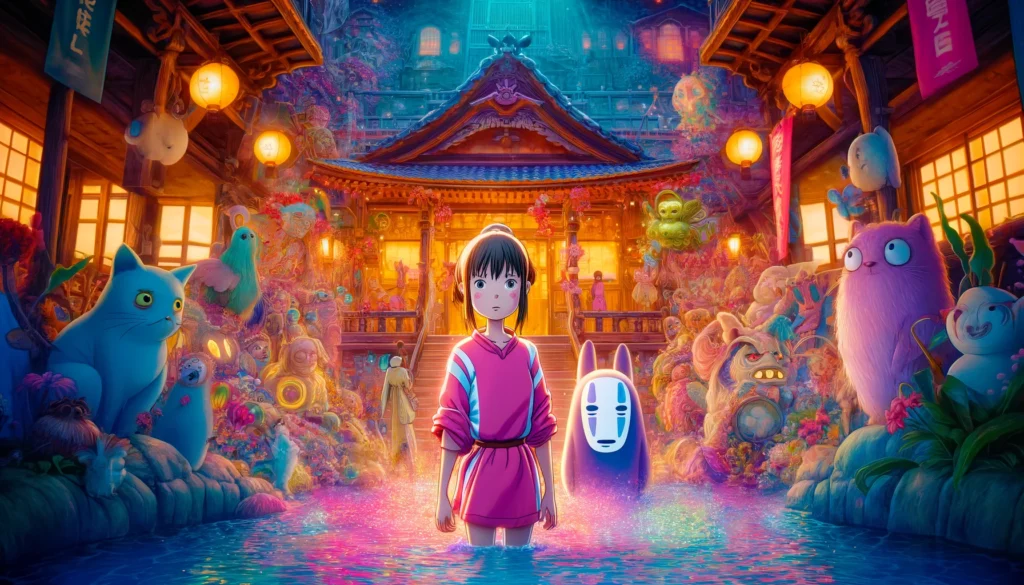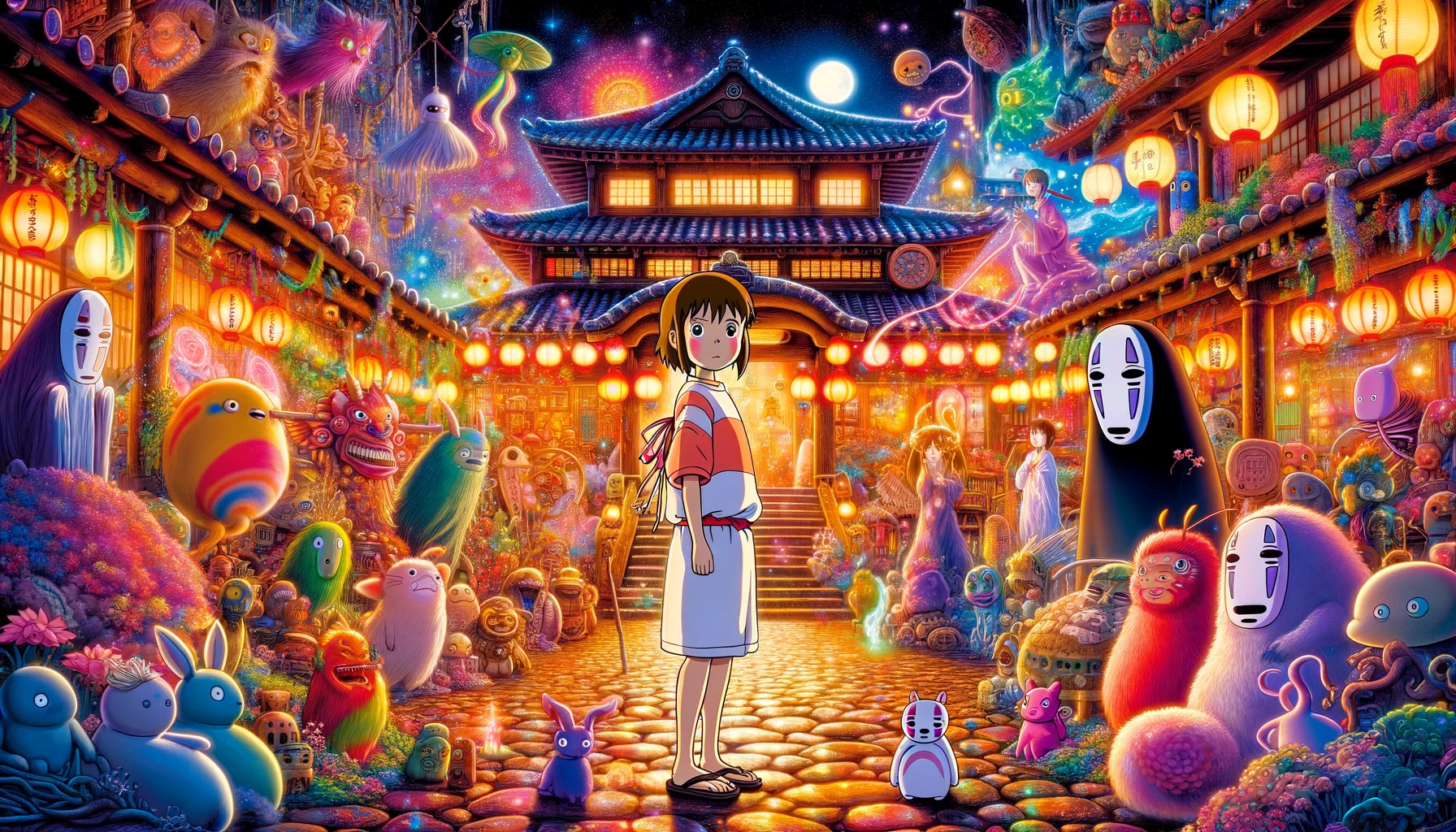
Table of Contents
Introduction
“Spirited Away,” directed by the legendary Hayao Miyazaki and produced by Studio Ghibli, is not just a film; it is an experience that transcends the boundaries of animation. Released in 2001, this enchanting movie has captured the hearts of audiences worldwide and stands as a testament to the artistry and storytelling prowess of Studio Ghibli. This review delves deep into the narrative, characters, themes, and the magical world of “Spirited Away,” exploring why it remains a beloved classic in the anime and cinematic world.
The Plot: A Journey into the Unknown
“Spirited Away” follows the story of Chihiro Ogino, a ten-year-old girl who, while moving to a new neighborhood with her parents, stumbles upon a mysterious and abandoned amusement park. As night falls, the park transforms into a magical realm inhabited by gods, spirits, and demons. Chihiro’s parents are turned into pigs by a witch named Yubaba, leaving her to navigate this strange world alone.
Determined to save her parents, Chihiro takes on the name Sen and secures a job in Yubaba’s bathhouse, a place where spirits come to rejuvenate. The plot intricately weaves Chihiro’s journey of self-discovery, courage, and resilience as she encounters a host of fascinating characters and overcomes numerous challenges.
Characters: A Cast of Memorable Figures
- Chihiro/Sen: The protagonist of the story, Chihiro’s character development is profound. From a whiny, scared little girl, she transforms into a brave and determined young heroine. Her journey is a testament to the resilience and growth of the human spirit.
- Haku: A mysterious boy who helps Chihiro navigate the spirit world. Haku is revealed to be a river spirit who once saved Chihiro, and their bond forms the emotional core of the movie.
- Yubaba: The formidable witch who runs the bathhouse. Yubaba’s character is both terrifying and humorous, embodying the duality of many of Miyazaki’s characters.
- Lin: A worker at the bathhouse who becomes Chihiro’s friend and guide. Lin’s tough exterior hides a caring heart, and she plays a crucial role in helping Chihiro adapt to her new surroundings.
- No-Face: A spirit who becomes infatuated with Chihiro. No-Face’s journey from a lonely, misunderstood spirit to a more self-aware being parallels Chihiro’s own growth.
Themes: Deep and Resonant Messages
“Spirited Away” is rich with themes that resonate deeply with viewers of all ages:
- Coming of Age: Chihiro’s transformation from a frightened girl to a confident individual is a classic coming-of-age narrative. The challenges she faces and the responsibilities she takes on symbolize the journey from childhood to adulthood.
- Environmentalism: A recurring theme in Miyazaki’s works, “Spirited Away” subtly critiques industrialization and pollution. The transformation of Haku from a river spirit to a servant of Yubaba symbolizes the loss of nature to urban expansion.
- Identity and Self-discovery: The concept of identity is central to the film. Chihiro’s loss of her name to Yubaba represents the struggle to maintain one’s identity in the face of adversity.
- Greed and Consequences: The transformation of Chihiro’s parents into pigs is a stark metaphor for human greed. The film criticizes the consumerist culture and highlights the importance of humility and respect for the environment.
Visuals: A Feast for the Eyes
Studio Ghibli’s attention to detail is unparalleled, and “Spirited Away” is a visual masterpiece. The animation is hand-drawn, giving it a unique and organic feel that sets it apart from computer-generated imagery. The bathhouse, with its intricate designs and vibrant colors, is a character in itself, reflecting the eclectic mix of spirits that inhabit it.
The use of light and shadow, the fluidity of motion, and the meticulous background art create a world that is both fantastical and believable. Each frame is a work of art, filled with subtleties that invite multiple viewings to fully appreciate.
Music: An Emotional Soundscape
Joe Hisaishi’s score for “Spirited Away” is nothing short of magical. The music enhances the emotional depth of the film, from the hauntingly beautiful “One Summer’s Day” to the whimsical “The Sixth Station.” Hisaishi’s compositions are integral to the storytelling, accentuating the highs and lows of Chihiro’s journey and immersing the audience in the world of the spirits.
Cultural Significance: A Global Phenomenon
“Spirited Away” is not only a critical success but also a cultural phenomenon. It won the Academy Award for Best Animated Feature in 2003, making it the first (and so far only) non-English language film to win in this category. The movie’s success has significantly contributed to the global recognition of anime as a serious art form.
The film’s impact extends beyond awards. It has inspired countless artists, filmmakers, and writers, and its themes of environmentalism and identity continue to resonate in today’s world. “Spirited Away” has become a touchstone for discussions about animation, storytelling, and the power of cinema to transcend cultural boundaries.
Analysis: A Deeper Look into the Narrative
- Symbolism and Metaphor: “Spirited Away” is rich with symbolism. The bathhouse represents a place of transformation and purification, mirroring Chihiro’s journey. The river spirit polluted with sludge is a clear metaphor for environmental degradation. Yubaba’s dual role as both antagonist and protector of the bathhouse reflects the complexity of human nature.
- Character Arcs and Development: The characters in “Spirited Away” are multidimensional and undergo significant development. Chihiro’s growth is mirrored by Haku’s rediscovery of his identity and No-Face’s evolution from a lost soul to a contented being.
- Miyazaki’s Influence: Hayao Miyazaki’s vision and philosophy permeate every aspect of “Spirited Away.” His love for nature, fascination with the supernatural, and belief in the resilience of the human spirit are evident throughout the film. Miyazaki’s storytelling is layered and complex, inviting viewers to look beyond the surface and explore the deeper meanings within the narrative.
Legacy: Enduring Impact and Future Generations
“Spirited Away” continues to inspire new generations of viewers and creators. Its themes are timeless, and its artistry remains a benchmark in animation. The film has been re-released in various formats, ensuring that it reaches a broad audience. Studio Ghibli’s dedication to preserving the hand-drawn animation technique in an era dominated by CGI is a testament to the enduring value of traditional artistry.
Conclusion: A Timeless Masterpiece
In conclusion, “Spirited Away” is more than just an anime movie; it is a timeless masterpiece that has left an indelible mark on the world of cinema. Its rich narrative, complex characters, stunning visuals, and emotive music combine to create an experience that transcends cultural and linguistic barriers. Whether viewed as a coming-of-age story, a critique of environmental degradation, or a journey of self-discovery, “Spirited Away” offers something for everyone. It stands as a testament to the power of storytelling and the magic of animation, solidifying its place as one of the greatest films ever made.
FAQs about Spirited Away
1. What is the main message of Spirited Away?
The main message of “Spirited Away” is about self-discovery, courage, and the importance of maintaining one’s identity in the face of adversity. It also touches on themes of environmentalism and the consequences of greed.
2. Why is Spirited Away considered a masterpiece?
“Spirited Away” is considered a masterpiece due to its intricate storytelling, complex characters, stunning animation, and profound themes. It successfully blends fantasy with deep, resonant messages, making it a timeless classic.
3. Who is the most important character in Spirited Away?
Chihiro, also known as Sen, is the most important character as the entire narrative revolves around her journey of growth and self-discovery. However, characters like Haku, Yubaba, and No-Face play crucial roles in her development.
4. What makes the animation in Spirited Away unique?
The animation in “Spirited Away” is unique due to its hand-drawn style, attention to detail, and the vibrant, imaginative world created by Studio Ghibli. The visual richness and fluidity of motion set it apart from typical animated films.
5. How does Spirited Away reflect Hayao Miyazaki’s vision?
“Spirited Away” reflects Hayao Miyazaki’s vision through its themes of nature, spirituality, and the resilience of the human spirit. Miyazaki’s storytelling is layered, and his dedication to hand-drawn animation underscores his commitment to traditional artistry.
Watch Now: Link 1

[…] by WIT Studio (Seasons 1-3) and MAPPA (Season 4), the animation quality of “Attack on Titan” is […]
[…] Since its debut, “Demon Slayer” has had a massive impact on the anime industry. It has broken records in both manga sales and anime viewership, with the movie “Demon Slayer: Mugen Train” becoming the highest-grossing anime film of all time, surpassing even Studio Ghibli’s “Spirited Away.” […]